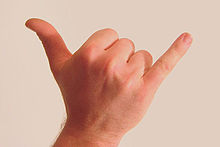Shaka (sign)
The word Shaka , accompanied by a typical hand position in which the closed fist is raised with the thumb and little finger spread apart (see illustration), is a gesture commonly used in Hawaii and by the surfers there among these athletes , which is used on various occasions is used and means something like “ cool !”, “easy!”, “okay!”, “good wave”.
distribution
The sign is common among windsurfers as a greeting and is referred to as "Hang Loose". Here, however, this greeting has a very real application: the splayed fingers stand for the trapeze rope and the fist for the hook of the trapeze with which the windsurfer attaches himself. This allows the surfer to relieve the pressure on his arms and hold the pressure of the wind with his body weight, he "hangs" in the sail.
Among surfers, the Shaka stands for a so-called "A-Frame". An A-frame is a wave that describes the perfect wave design or breaking of a wave. The wave breaks at only one point and can be surfed both to the right and to the left. Since the middle finger is the longest finger on the hand, it represents the peak or highest point of a wave, which is followed by the index and ring fingers when the hand closes to greet the Shaka. The symbolism corresponds to surfing a wave to the left and right. The thumb and little finger correspond to the spray that is pressed out of the tunnel (barrel, tube) when the wave breaks hollow.
origin
The exact origin is ultimately not certain, but a number of theories exist. According to the Polynesian Cultural Center as well as research by the Honolulu Star Bulletin , at least the hand sign goes back to the Hawaiian Kalili Hamana († around 1940), who was three fingers missing on one hand.
It is unclear where the accompanying call comes from. The fricative it contains suggests that it probably does not come from the Hawaiian language . One origin could be the used car dealer David "Lippy" Espinda, who in the 1960s his TV advertising with this hand sign and an enthusiastic "Shaka, brah!" finished.
Use in public
The combination of gesture and exclamation was often used by the Hawaiian television actor David 'Lippy' Espinda († 1975) in his television appearances. The Hawaiian politician Frank Fasi used it in his election campaigns since the 1970s.
The gesture is widespread in the Polynesian region as a greeting gesture among local residents, so it can also be observed on Easter Island and in French Polynesia .
Elvis Presley also used the gesture in his concert “Aloha From Hawaii” on January 14, 1973, when he left the stage at the end of the show.
US President Barack Obama used this gesture to greet MPs from Hawaii - he grew up in Hawaii.
The Brazilian soccer player and two-time world soccer player Ronaldinho often used this gesture when celebrating goals. However, he waved both of his hands in addition.
Web links
- Honolulu Star Bulletin , March 31, 2002
Individual evidence
- ↑ Polynesian Cultural Center ( Memento from September 14, 2008 in the Internet Archive )
- ↑ Cheryl Chee Tsutsumi: The Origin of the Shaka. Accessed September 4, 2018 .
- ↑ Obama Says "Hang Loose" ( December 31, 2008 memento on the Internet Archive ) on thewashingtonnote.com
